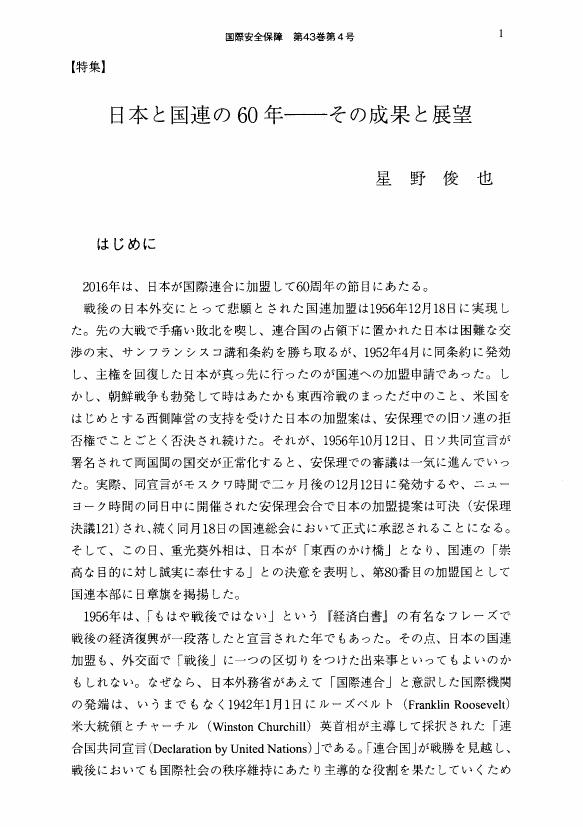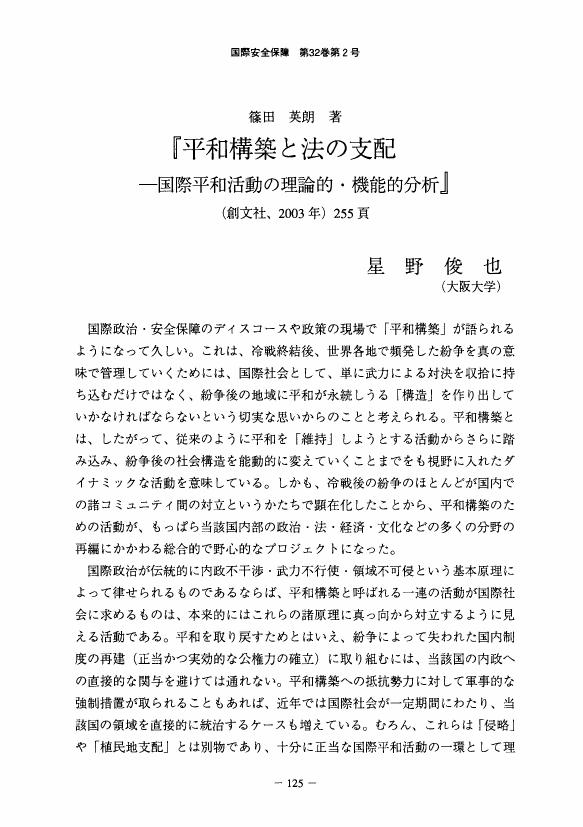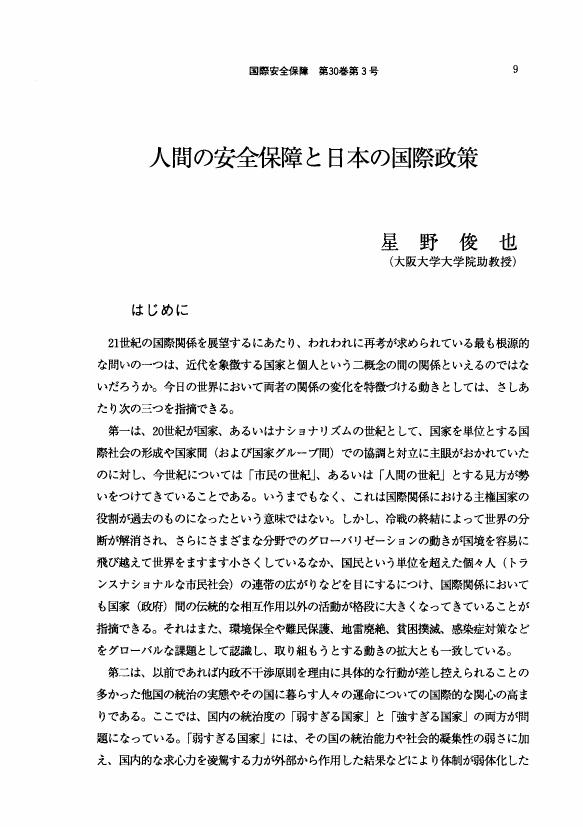1 0 0 0 OA 日本と国連の60年――その成果と展望
- 著者
- 星野 俊也
- 出版者
- 国際安全保障学会
- 雑誌
- 国際安全保障 (ISSN:13467573)
- 巻号頁・発行日
- vol.43, no.4, pp.1-7, 2016-03-31 (Released:2022-04-01)
1 0 0 0 OA 神余 隆博 著『国際危機と日本外交』
- 著者
- 星野 俊也
- 出版者
- 国際安全保障学会
- 雑誌
- 国際安全保障 (ISSN:13467573)
- 巻号頁・発行日
- vol.34, no.4, pp.113-117, 2007-03-31 (Released:2022-04-20)
1 0 0 0 OA 篠田 英朗 著『平和構築と法の支配―国際平和活動の理論的・機能的分析』
- 著者
- 星野 俊也
- 出版者
- 国際安全保障学会
- 雑誌
- 国際安全保障 (ISSN:13467573)
- 巻号頁・発行日
- vol.32, no.2, pp.125-128, 2004-09-30 (Released:2022-04-24)
1 0 0 0 OA 人間の安全保障と日本の国際政策
- 著者
- 星野 俊也
- 出版者
- 国際安全保障学会
- 雑誌
- 国際安全保障 (ISSN:13467573)
- 巻号頁・発行日
- vol.30, no.3, pp.9-25, 2002-12-31 (Released:2022-04-28)
1 0 0 0 OA 国連安保理改革の重層的研究:歴史、政治、投票力、実効性の観点から
まず、シンポジウム(小規模およびマローン国連大学長や外務省関係書が参加した国際シンポジウム)を二回開催し、安保理改革の歴史やその停滞などを多角的に論じるなどし、専門家との議論ばかりではなく、一般への広報活動に努めた。また、HPを立ち上げ、随時研究成果を公表した。研究成果に関しては、各分担者の担当分野を主眼とした論文や分担執筆などを活発に行った。また、大阪大学において、大学院向けの科目をあらたに設置し、教育にも努め、その成果の一部として、安保理における投票行動の分類別データベースも作成した。本科研の研究期間以内に、その研究成果を書籍として世に問うつもりであったが、残念ながら間に合わなかった。
1 0 0 0 OA 国連とアジア太平洋の安全保障-集団的安全保障と集団的自衛の間-
- 著者
- 渡辺 昭夫 星野 俊也
- 出版者
- 財団法人 日本国際政治学会
- 雑誌
- 国際政治 (ISSN:04542215)
- 巻号頁・発行日
- vol.1997, no.114, pp.57-71,L9, 1997-03-30 (Released:2010-09-01)
- 参考文献数
- 20
What about regional solutions to regional security questions? After the United Nations has experienced both successes and setbacks in dealing with a series of post-Cold War regional crises, the inter-relationship (or the appropriate balance) between global (i. e. the UN) and regional mechanisms to manage and to help resolve these conficts has become a recurring subject for discussion. And it is especially so in the Asia Pacific region. The rather anomalous security environment of which is exemplified in the duality of “hub-and-spokes”-type bilaterals alliances (à la the US-Japan alliance) and multilateral security frameworks (like the ASEAN regional forum, or ARF).In fact, the tension between global and regional mechanisms, and the applicability thereof, was evidenced from the very beginning of the drafting of the UN Charter. They are both “collective” measures which can involve military options. But they are distinct in that the former can be called, in its ideal form, a system of “collective security” based on the principle of universality and inclusiveness while tha latter, being naturally limited in its membership, can be characterized as that of “collective self-defense.” Conceptually these two logics are supposed to be mutually exclusive, but in reality the function of regional security mechanisms can be found somewhere in the middle ground between collective security and collective self-defense. For example, the post-Cold War NATO has changed the nature of its functions and so has the bilateral alliance between the US and Japan, both of which are assuming the stabilizing role as “public goods” beyond collective self-defense.In the Asia Pacific region, the anomaly of the security environment has not permitted us to envision a region-wide collective security mechanism encompassing all the relevant countries that is firm enough to capture especially commitment from the four regional major powers—the US, China, Russia and Japan. On the other hand, a series of efforts toward what might be called “cooperative security” undertaken regionally which are not predicated on military enforcement do contribute positively to enhance confidence-building. In this period of transition, security in the region will entail a complex of security mechanisms composed of “hub-and-spokes”-type alliances with growing “public goods” role and informal multilateral “cooperative security” dialogue rather than building a hard security regime in the Asia Pacific. Coupled with these developments, however, it would be most productive to pursue concerted diplomacy among the three major powers (the US, China and Japan). It is certainly a long way to draw political contours that fits the Concert of Pacific Asia, but that seems the most plausible option available to these three countries in the twenty-first century.



